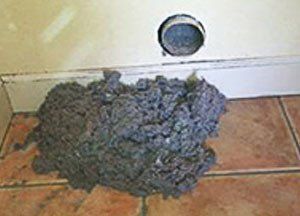Factors that influence airflow and the buildup of lint in your transition duct
• Type of clothing and material dried
• Presence of pet hair
• Lack of proper maintenance
• Length of the exhaust vent
• Regular cleaning of the lint filter
• Limited air intake due to lack of makeup air or a tight home

Get your dryer duct inspected and cleaned today!
Some dryer duct systems will need to be cleaned more often to provide you with a safe and trouble-free clothes drying operation. Let us inspect and clean your dryer with our professional tools and improve its performance.
Other factors to keep in mind:
- The dryer exhaust vent must have a diameter of at least 4 inches, and be as large as the dryer outlet and transition duct
- The transition duct, which runs to the exhaust vent from the rear of the dryer, should be made of metal or UL listed for that specific use. Plastic should not be used as it will add to flames rather than containing it if a fire occurs.
- If your dryer vent exhaust systems are concealed in walls or through attics, they must be made of aluminum pipe, rigid metal pipe, or UL listed for this purpose or approved by the local authority having jurisdiction in the matter
- The dryer vent exhaust system must be independent of other venting systems, and must end outdoors
- The outside termination vent should feature a back-draft damper or flapper
- The total length of the dryer exhaust system should not exceed 25 feet unless permitted by the dryer manufacturer . Each 45-degree elbow will be counted as 2-1/2 feet of that length
- Joints in ducts and exhaust vents should be secured with metal foil tape rather than screws or rivets that may reduce airflow by collecting lint inside the vent
- Exhaust vent pipe joints should be installed so the male end of the pipe is installed in the direction of airflow. This also reduces the chances of lint catching on the pipe joint and reduces turbulence in the pipe, both of which will reduce airflow
- The termination vent should be cleaned and checked for airflow every couple of months
- You should clean or vacuum the area around the dryer, the exhaust vent inlet, the rear of the dryer, the intake grills, and the transition duct
- Test the efficiency of your dryer by recording the amount of time, the settings used, and the number of towels just after the vent has been cleaned. Every couple of months, repeat this test and compare the times. When the time comparison exceeds ½ of the time, it is time for you to contact us for a cleaning.
- If your dryer operates on gas, you should have a carbon monoxide detector in your home for your protection in the event a blockage in the dryer exhaust system occurs
